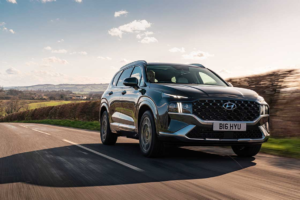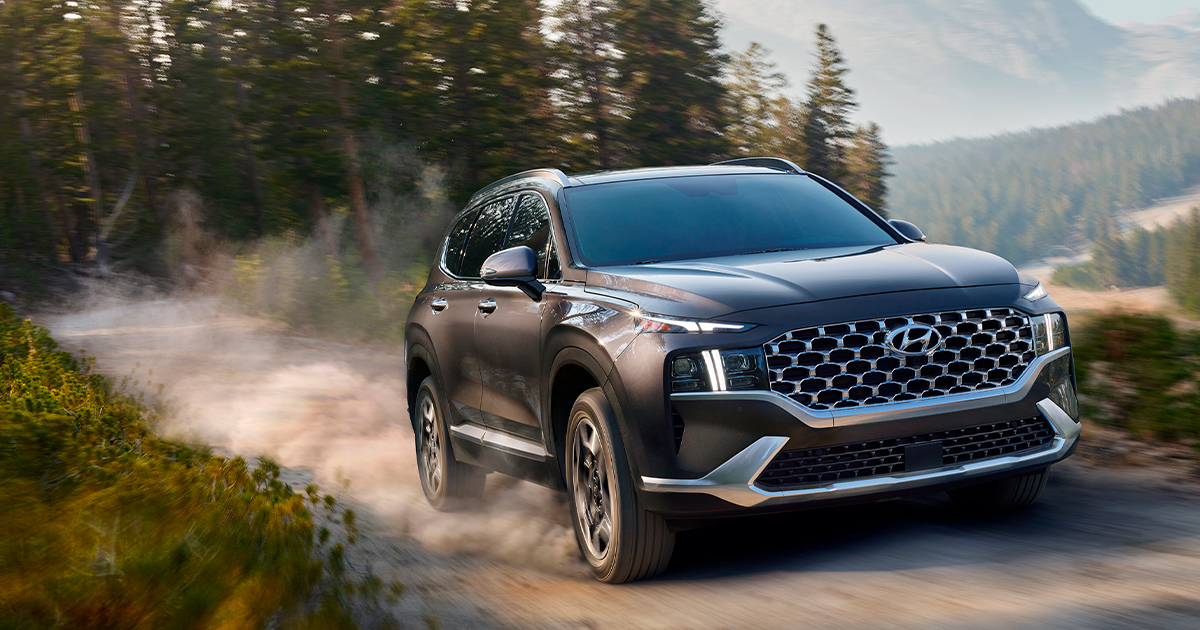We’ve praised the plug-in hybrid (PHEV) version of Hyundai’s midsize Santa Fe for its value, specifically because it offers midsize cabin space for the same price as Toyota’s compact RAV4 Prime plug-in. The spacious, high-luxe interior is a definite strong point, but what about performance? Time to strap on the timing gear and see what kind of numbers we get.
The plug-in Santa Fe shares its 1.6-liter turbocharged four with the regular Santa Fe hybrid but gets a more powerful electric motor, which brings 90 hp and 224 hp to go with the gas engine’s 178 hp and 195 lb-ft. Through the magical vagaries of hybrid math, total system output is 261 hp, 35 hp more than the regular hybrid. (If you’re a closet Hyundai statistician, it’s also 20 hp less than the most powerful Santa Fe variant, the non-hybrid 2.5T.) The PHEV also has a larger battery than the regular hybrid, giving it a healthy 31 miles of all-electric range.
 We’ve tested these other variants of the Santa Fe, and because we are closet Hyundai statisticians, we were curious how they’d compare. First, acceleration: The Santa Fe PHEV made it from 0 to 60 mph in 7.0 seconds and took the quarter mile down in 15.2 seconds at 93.1 mph. That made it significantly quicker than the regular hybrid, which we timed at 8.2 seconds to 60 and 16.2 in the quarter, but not as fleet of tire as the 2.5T, which made 60 in 6.2 and ran the quarter in 14.6. T. The Santa Fe’s ability, like other Hyundai/Kia hybrids, to deliver power smoothly and evenly across the rev range is quite impressive.
We’ve tested these other variants of the Santa Fe, and because we are closet Hyundai statisticians, we were curious how they’d compare. First, acceleration: The Santa Fe PHEV made it from 0 to 60 mph in 7.0 seconds and took the quarter mile down in 15.2 seconds at 93.1 mph. That made it significantly quicker than the regular hybrid, which we timed at 8.2 seconds to 60 and 16.2 in the quarter, but not as fleet of tire as the 2.5T, which made 60 in 6.2 and ran the quarter in 14.6. T. The Santa Fe’s ability, like other Hyundai/Kia hybrids, to deliver power smoothly and evenly across the rev range is quite impressive.
Braking from 60 took 125 feet, a little longer than the regular hybrid (123 feet) and the 2.5T (117). This is likely a function of weight: At 4,496 pounds, the plug-in Santa Fe is some 270 pounds heavier than the hybrid, which itself is just over 200 pounds heavier than the 2.5T.
As it happens, the PHEV was not the slowest Santa Fe around our figure-eight test; at 27.9 seconds, it was 0.1 second quicker than the Santa Fe hybrid, though average skidpad grip was identical at 0.79 g. (The Santa Fe 2.5T was quite a bit stickier at 0.83 g and consequently lapped the figure eight quicker, at 26.7 seconds.)
The figure eight is a test that goes beyond numbers, as it requires the powertrain, brakes, and suspension to work together (hopefully) in harmony. The team had good things to say about the plug-in’s handling: “Really well behaved for what it is, and even a little bit of fun. Smooth shifting and good brakes with modest dive, but it’s predictable. The power surges a little on the skidpad, making it difficult to maintain a constant speed, but there’s good balance between understeer and oversteer.”
 No surprises, then: The second-most-powerful Santa Fe is also the second-quickest, with handling that provided a few unexpected smiles. So along with its generous interior and commutable all-electric range—enough that many drivers may need scarcely any gasoline at all—the Santa Fe delivers good performance for a vehicle in its class.
No surprises, then: The second-most-powerful Santa Fe is also the second-quickest, with handling that provided a few unexpected smiles. So along with its generous interior and commutable all-electric range—enough that many drivers may need scarcely any gasoline at all—the Santa Fe delivers good performance for a vehicle in its class.
Sounds like good value to us. We highly recommend.
source: motortrend




